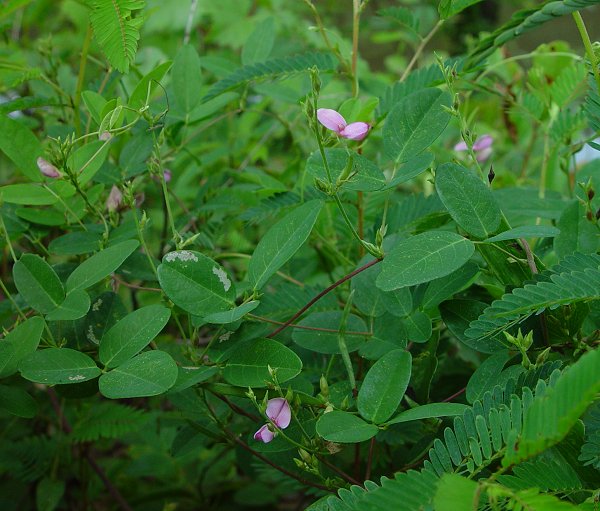Galactia regularis (L.) Britton, Sterns & Poggenb.
Downy Milk Pea

Native
CC = 6
CW = 5
MOC = 48
© DETenaglia
Galactia regularis (L.) Britton, Sterns & Poggenb.Downy Milk Pea | |
 |
Native CC = 6 CW = 5 MOC = 48 |
© DETenaglia |
|
Family - Fabaceae/Faboideae Habit - Perennial forb with a slender, branched caudex above a taproot. Stems - Prostrate, trailing, or twining on other vegetation, to 90 cm, unarmed, sparsely to densely pubescent with short, fine, spreading to downward-curved hairs. Leaves - Alternate, pinnately trifoliate, stipulate, petiolate. Petioles 0.5-2.0 cm long, hairy. Stipules 1-3 mm long, narrowly lanceolate to lanceolate, mostly shed early; stipels minute (less than 0.3 mm long), linear, more or less persistent. Leaflets 1.5-4.0 cm long, 0.5-2.5 cm wide, elliptic to oblong or oblong-ovate, rounded to broadly angled at the base, bluntly pointed to rounded or slightly notched at the tip, the midvein extended as a minute sharp point at the very tip, the margins entire, the upper surface moderately hairy to glabrous or nearly so, the undersurface moderately to densely and finely hairy, pinnately veined. Terminal leaflet with the stalk 3-8 mm long, symmetric at the base; lateral leaflets essentially sessile above the pulvinus, mostly symmetric at the base.
Inflorescences - Axillary clusters or racemes of 2-10 flowers, sometimes paired, the inflorescence stalk 0.5-3.0 cm long, hairy, the bracts 1.0-1.5 mm long, lanceolate, shed early; bractlets 0.6-1.0 mm long, ovate, loosely subtending the flowers, persistent.
Flowers - Calyces 4-6 mm long, 5-lobed, but often appearing 4-lobed because of fusion of the upper 2 lobes all or most of the way to the tip, the tube narrowly bell-shaped, hairy, the lobes about as long as to somewhat longer than the tube, the lowermost lobe longer than the others, ovate to triangular-lanceolate, angled or tapered to sharply pointed tips. Corollas papilionaceous, pink to pinkish purple, the banner 6-9 mm long, 4-5 mm wide, the expanded portion broadly obovate, shallowly notched at the tip, often with a shallow longitudinal keel, bent backward, with a white or pale region toward the center, this often with an irregular, darker purple margin, the wings 6-7 mm long, 1.5-2.0 mm wide, the expanded portion oblong, straight to somewhat incurved around the keel, the keel 6-8 mm long, 2-4 mm wide, straight to slightly curved upward, fused nearly to the usually bluntly pointed tip. Stamens 10, all of similar length, 9 of the filaments fused and 1 free, the fused portion 4-5 mm long, the free portion 1-2 mm long, the anthers small, attached near the midpoint. Ovary 3-4 mm long, finely hairy, the style 2-3 mm long, glabrous, the stigma minute, terminal.
Fruits - Legumes 2-5 cm long, 4-5 mm wide, narrowly oblong, straight, tapered at the tip to a short beak, flattened, herbaceous to somewhat papery, sparsely hairy at maturity, dehiscing by 2 valves, these green to tan at maturity, twisting spirally after dehiscence, with 3-8 seeds. Seeds 2.5-3.5 mm long, 1.5-2.5 mm wide, more or less kidney-shaped, flattened, the surface yellow to dark brown, sometimes mottled with purple, smooth, somewhat shiny.
Flowering - July - August. Habitat - Glades, savannas, dry upland forests, tops of bluffs, and sand prairies. Origin - Native to the U.S. Lookalikes - Species of Strophostyles and Phaseolus. Other info. - This species can be found in the southern half of Missouri, and in somewhat scattered fashion across much of the southeastern quadrant of the continental U.S. Southern Missouri is near the northwestern extent of its range. The plant is recognized by its vining habit, trifoliate leaves, and bean-pattern flowers. The leaflets tend to be smaller and rounder than those of its close lookalikes, and the calyces usually appear 4-lobed. Photographs taken at the Neusse River Nature Center, NC., 7-10-02 (DETenaglia); also at Sand Prairie Conservation Area, Scott County, MO, 8-8-2022 (SRTurner). |